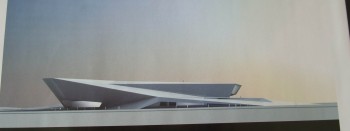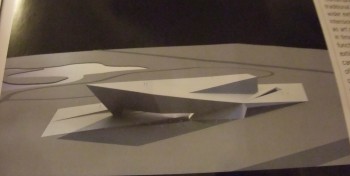Contemporary Art, China’s New Face
“I need a fighter, a lover of space, an agitator, a tester and a wise man… I want a temple of spirit, a monument!”
Hilla Rebay to Frank Lloyd Wright, 1943
In June 1943 Frank Lloyd Wright received a letter from Hilla Rebay, the art advisor to Solomon R. Guggenheim, asking the architect to design a new building to house Guggenheim’s 4-year –old Museum of Non-Objective Painting.
The Guggenheim Museum was born, becoming a focal point for contemporary art in the world.
After New York, Bilbao, Venice, Dubai…
Now Beijing is planned to build a museum of contemporary art of its own.
Plans for the new museum, to be designed by the Studio Pei Zhu of Beijing, were outlined on October 28, 2008, during a press briefing held by the Center of International Cultural Exchange at the Beijing.
The Contemporary Art Museum of China is an important part of the Beijing No 1 Art Base. The base is devoted to popularizing artistic conceptions and promoting cultural exchanges. One way it does this is by providing an art compound where artists from around the world can meet each other, exchange ideas and seek inspiration.
The Contemporary Art Museum will be art oriented information, training and conference centre and a base for artistic creation and exhibitions.
Designers Zhu Pei and Wu Tong, whose firm won a design competition for the project, described his work as “an outcrop from the ground” not simply a museum but an integral part of its environment.
The exterior design is very special; from the outside, you can go to the roof directly, so exhibitions can be presented outside, even on the roof
The design plan is full of passion and imagination; it reflects the mainstream of architectural design in the world today.
Construction will begin in 2009 and will be completed in 2010.
Art Contemporain, le Nouveau Visage de la Chine
“J’ai besoin d’un battant, d’un amoureux de l’espace, d’un agitateur, d’un testeur et d’un homme judicieux… Je veux un temple de l’esprit, un monument ! »
Hilla Rebay à Frank Lloyd Wright, 1943
En juin 1943 Frank Lloyd Wright a reçu une lettre de Hilla Rebay, le conseiller d'art à Solomon R. Guggenheim, demandant à l'architecte de concevoir un nouveau bâtiment pour héberger le Musée Guggenheim de Peinture Non-objective vieux de 4ans.
Le Musée Guggenheim était né, devenant un point focal pour l’art contemporain dans le monde.
Après New York, Bilbao, Venise, Dubai…
Maintenant Pékin a projeté de construire son propre musée d'art contemporain.
Les plans du nouveau musée, ont été conçus par le Studio Pei Zhu de Beijing, et présentés le 28 octobre 2008, pendant un point de presse organisé par le Centre d'Échange culturel International à Beijing.
Le Musée d’Art Contemporain de Chine est une part importante de la Base d’Art n° 1 de Pékin. Une base consacrée à populariser et promouvoir les échanges et conceptions artistiques et culturelles. Un concentré d'art où les artistes du monde entier pourront se rencontrer, échanger des idées et chercher l'inspiration.
Le Musée d’Art Contemporain sera un centre d’art, d’informations, d’orientations, de formation et de conférences et une base pour la création artistique et les expositions.
Les designers Zhu Pei et Wu Tong, dont la société a gagné la compétition de conception pour le projet, ont décrit leur travail comme "un affleurement du sol" pas simplement un musée, mais une partie intégrante de son environnement.
La conception extérieure est très spéciale; de l'extérieur, vous pouvez aller sur le toit directement, donc des expositions peuvent être présentées à l'extérieur, même sur le toit.
La conception est pleine de passion et d'imagination; elle reflète le courant dominant de la conception architecturale dans le monde d’aujourd'hui.
La construction commencera en 2009 et sera finie en 2010.


